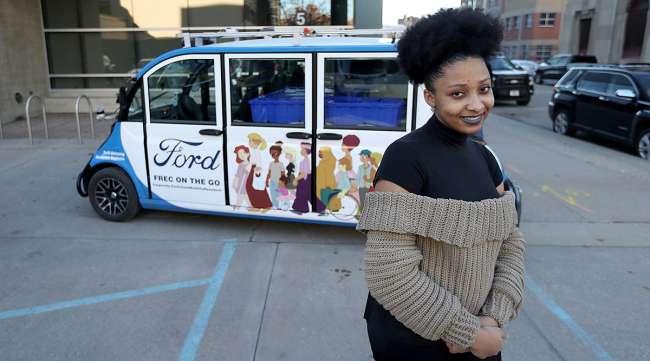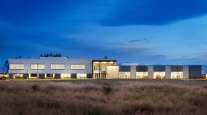The Detroit News
Ford to Launch Food Program in Detroit Using Autonomous Shuttle

[Stay on top of transportation news: Get TTNews in your inbox.]
In a move aimed both at fulfilling a community need and advancing vehicle technologies considered a key part of its future, Ford Motor Co. is launching a fresh food delivery pilot in southwest Detroit using an autonomous vehicle shuttle.
The Dearborn automaker, with its philanthropic arm the Ford Motor Co. Fund, on Dec. 14 announced a six-month initiative kicking off after the holidays that aims to deliver approximately 10,000 pounds of fresh food to residents of Rio Vista Detroit Co-op Apartments, a senior living center near Ford’s under-construction Michigan Central campus in Corktown.
The pilot builds on a free food program, called Ford Resource and Engagement Center on the Go, that the Ford Fund and Gleaners Community Food Bank launched earlier this year, doubling the existing food deliveries for more than 20 Rio Vista residents who participate in the service.
“We’re constantly thinking about how to expand our reach in communities for those who don’t have access to the most basic goods, like groceries or warm meals,” Joe Provenzano, mobility director for the Ford Fund, said in a statement. “Bringing Ford’s mobility expertise together with local collaborations allows us to create innovative solutions that make communities stronger and people’s lives better.”
The existing food delivery program operated by the Ford Fund and Gleaners already has distributed roughly 2.4 million pounds of food, according to a news release. Participants receive a mixture of dry and canned goods, plus fresh produce, milk and cheese. The pilot program will bring participants an additional delivery, containing fresh produce and milk, each month.
The pilot will use a low-speed autonomous shuttle that will run along a fixed route between the Southwest Detroit Ford Resource and Engagement Center and Rio Vista. A safety driver will be inside the vehicle at all times, and a team will remotely monitor the shuttle.
Ford also revealed the shuttle’s exterior art design by Detroit School of Arts 12th-grader Brooke Snow. Ford gave Snow $5,000 for her contribution, which the company said she planned to put toward her college expenses.

A closer look at the Ford autonomous shuttle. (Max Ortiz/The Detroit News via Tribune Content Agency)
The pilot is just the latest effort by Ford to advance its self-driving capabilities, an endeavor in which it’s committed to investing $7 billion through 2025. That investment includes numerous initiatives aimed at launching a commercial AV business at scale in 2022, with self-driving technology partner Argo AI.
The automaker and its partners, for example, conducted a similar program about a year ago in Florida’s Miami-Dade County, delivering food and school supplies. In July, Ford and Argo announced plans to launch a limited robotaxi service on ride-sharing company Lyft’s platform. And in September, they announced they were teaming up with retail giant Walmart Inc. to offer an autonomous vehicle delivery service in Miami, Austin and Washington, D.C.
The southwest Detroit pilot, however, does not involve Argo’s technology, but that of Ford Autonomous Vehicle Future Tech team and Saline-based Quantum Signal AI, a wholly owned Ford subsidiary.
John Davis, Ford’s director of autonomous vehicle and future technology, said in a blog post Dec. 14 that Ford hopes to use the pilot to improve on autonomous testing, design and how such services affect the communities where they operate.
One thing the team will test is how a remote operator based in Saline could assist the shuttle in the case of an unexpected driving condition, such as a tree branch falling into the shuttle’s path. Davis noted the team also has installed multiple “smart infrastructure sensor nodes” along the shuttle’s route. Those nodes can relay information to a self-driving vehicle, helping it anticipate on-the-ground conditions before it encounters them.
The team also is using the pilot to improve the shuttle’s design. It was redesigned to make it easier to transport goods, a function that Ford executives have said they view as a key focus for future AV commercial services. Doors were repositioned, digital screens with the ability to display messages were incorporated, and a light bar was added to the windshield and windows as a means of signaling to pedestrians and drivers.
Ford said it will be gathering feedback, including via focus groups, on every aspect of the service over the course of the pilot.
“We believe this type of autonomous application could be used in the future and could help support more frequent trips and deliveries in our communities,” Davis wrote. “This is a step in our journey as we use the open innovation platform at Michigan Central to build mobility solutions for the future.”
Want more news? Listen to today's daily briefing below or go here for more info:
Distributed by Tribune Content Agency, LLC




